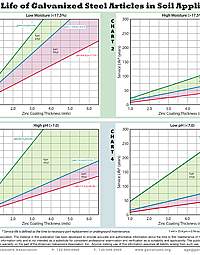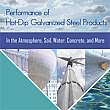A common exposure for hot-dip galvanized steel is partially or fully buried in soil. With more than 200 different types of soil identified in North America, hot-dip galvanizing's performance in soil is varied and hard to predict. The main factors that dictate the corrosivity of the soil are moisture content, pH level, and chlorides. These soil conditions are affected by additional characteristics such as aeration, temperature, resistivity, and texture or particle size. A general rule of thumb is galvanizing performs well in brown sandy soils, and not as well in gray, clay-like soils. This is because soil with larger particles wick moisture away from the surface more quickly so the galvanized piece has less exposure to moisture.
The first step to estimating the performance of hot-dip galvanized steel in soil is to classify it. The AGA has developed a chart for estimating HDG's performance in soil based on real world corrosion data. Service life is defined as total consumption of the coating plus 25%, and is an indication of when the structure should be replaced.
Created in 2010, this 2-sided, full color chart shows the performance of galvanized steel in various soil conditions. The front side includes four graphs representing different soil classifications, and the reverse side provides detailed descriptions of each chart, along with general information regarding the service life chart data and development.


